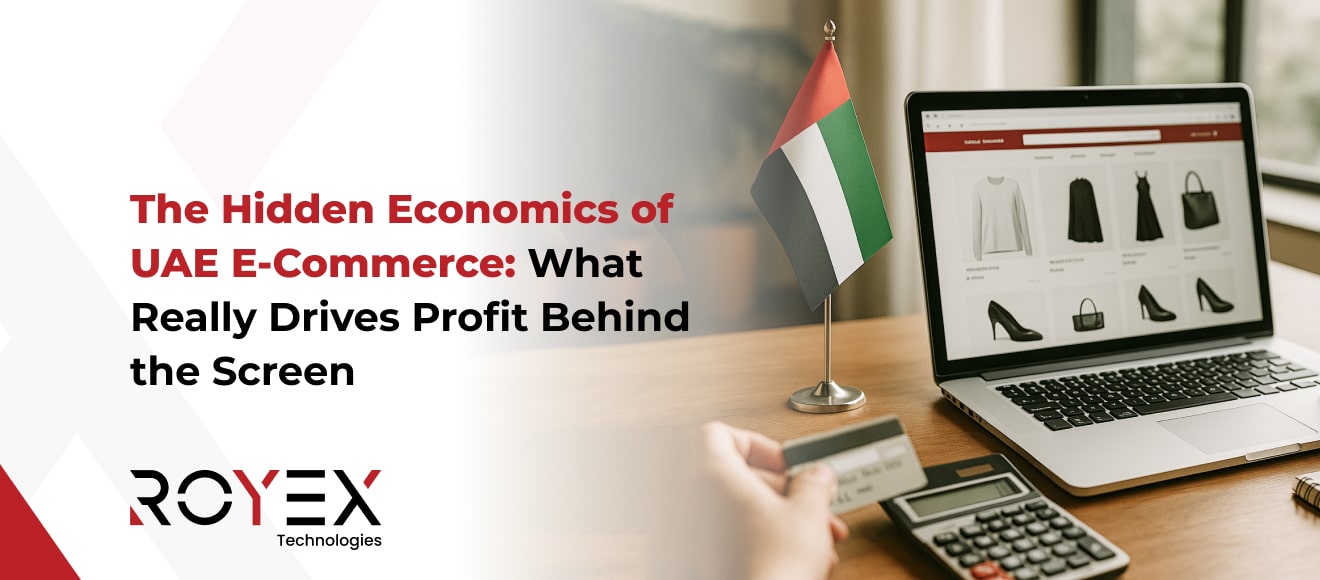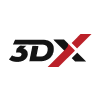
The Hidden Economics of UAE E-Commerce: What Really Drives Profit Behind the Screen
E-commerce in the UAE looks glossy on the surface — slick websites, fast checkouts, eye-catching promos — but the real story of profitability lives beneath the UI. Behind every successful online sale are a handful of economic levers: margins, logistics, payments, customer lifetime value, returns, and the structural forces of marketplaces and regulation. This article pulls back the curtain on those hidden economics and gives UAE merchants — and the teams building for them — a practical blueprint to turn clicks into sustainable profit.
Snapshot: the UAE e-commerce market reached roughly USD 6.9–7.5 billion in recent years and is forecast to grow steadily, with smartphone-driven commerce and marketplaces playing outsized roles.
1. Why “surface metrics” lie: revenue vs. profit
It’s tempting to celebrate headline revenue: “We did AED 1M in sales!” But revenue alone doesn’t pay salaries, shipping bills, or inventory costs. Profitability lives in the fine print:
-
Gross margin (price minus COGS) determines whether you can sustainably spend on customer acquisition.
-
Fulfillment & returns costs quietly erode margins, especially in geographies with expensive last-mile delivery or high return rates.
-
Channel mix matters: marketplace sales can grow GMV quickly but take platform fees, commissions, and sometimes forced discounts.
Most early-stage e-commerce teams focus on top-of-funnel growth (traffic and conversion) while under-indexing on the back-end costs that transform revenue into profit. The rest of this article explains those back-end drivers in UAE context.
2. Market context: size, growth, and who’s buying
Understanding the scale and dynamics of the UAE market reframes how you price, fulfill, and market:
-
Market size & growth: Recent market estimates put UAE e-commerce revenue in the USD 6.9–7.5 billion range for 2024, with forecasts pointing to continued growth through the decade. Smartphone adoption and increasing user penetration (projected ~46–47% in 2024 rising through the decade) are core growth drivers. weareprocarrier.com+1
-
Device-driven commerce: Smartphones dominate. Some industry reports show smartphones accounted for ~79% of e-commerce revenue share in 2024 — meaning mobile UX is not optional, it’s central. Mordor Intelligence
-
Regional leadership: The UAE ranks among the top e-commerce markets in the GCC, buoyed by high disposable incomes, tourism, and trade hubs. Non-oil trade expansion and logistics investments are further tailwinds. Reuters
Implication: the UAE is mature enough that you must design for mobile, for multi-lingual customers (Arabic + English), and for cross-border commerce flows.
3. Unit economics 101: margin, AOV, and CAC
Profitability reduces to a few algebraic truths. If you want to know whether an acquisition channel or promotion is smart, plug numbers into this simplified model:
LTV (lifetime value) = AOV × Purchase Frequency × Gross Margin × Retention Rate
Sustainable CAC ≤ LTV × Acceptable Payback Window
Key UAE figures to use as benchmarking inputs:
-
Average Order Value (AOV) — public data shows regional and UAE AOVs vary widely by sector; one aggregated source cited AOV around USD 68–102 depending on the dataset and period, while other regional analyses showed AOV growth into higher brackets for the UAE specifically (UAE AOV rising into the triple figures in some reports). Always compute AOV for your own SKUs and channels. CEIC Data+1
-
Cart & checkout leakage — cart abandonment globally averages ~70%, and APAC/EMEA figures can be even higher, which makes recovery flows one of the highest ROI fixes. In UAE benchmarking, add-to-cart and abandonment patterns suggested add-to-cart around 11% with cart abandonment rates above 75% in some market datasets. Baymard Institute+1
Interpretation: a small lift in AOV (bundles, cross-sells) or a small reduction in abandonment recovers much more profit than a proportionate increase in top-of-funnel spend.
4. The payments shift: why payment method choice impacts profit
Payment methods are more than convenience — they’re a direct profit lever.
-
Cash on delivery (COD) historically inflated conversion where card trust was low, but COD brings higher return & handling costs and sometimes fraud. In the MENA region, COD preference has halved over recent years (from ~41% to ~20% region-wide), with UAE showing lower COD preference in more mature segments. This decline matters because digital payments reduce handling costs and failed delivery friction. Checkout.com
-
Card & digital wallet adoption: Cards and wallets now account for a substantial share of online payments, reducing the hidden cost of COD and enabling subscription billing, BNPL (Buy-Now-Pay-Later), and instant authorizations that cut failed order rates. Mordor Intelligence+1
-
Payment fees & chargebacks: Transaction fees (gateway, acquiring bank) and chargebacks directly lower margin. Choose payment partners by netting expected dispute rates, settlement times (USD vs AED), and integration costs.
Practical: offering multiple digital payment options and encouraging pre-payment with small UX nudges (e.g., discounts for prepaid, installment plans for big tickets) improves net profitability by reducing operational cost and failed delivery rates.
5. Logistics & fulfillment: the invisible cost center
Fulfillment is where ambitious gross margins often evaporate. The UAE’s geography, consumer expectations for fast delivery, and marketplace Fulfillment-as-a-Service norms all shape costs.
-
Last-mile economics: Last-mile costs in UAE urban areas can be high relative to product margins, especially for low AOV categories. Heavy or oversized goods carry outsized delivery fees that must be embedded into pricing or passed to customers.
-
Marketplace logistics pressure: Marketplaces like Noon and Amazon offer logistics standards that set customer expectations — including fast delivery and easy returns — which raise the bar for standalone merchants. Noon has scaled significantly in the region and is working on logistic efficiencies to reduce driver counts via automation — a signal that fulfillment costs are a strategic battleground. Financial Times
-
Cross-border trade & duties: If you source internationally, customs clearance, duties, and cross-border transport time add complexity and working capital drag. The UAE’s favorable trade infrastructure helps, but proper landed cost accounting is essential.
Bottom line: model per-order fulfillment cost (including returns handling) before promising free shipping. Many UAE merchants use a minimum-order free shipping threshold to protect margins and lift AOV.
6. Returns, exchanges, and reverse logistics economics
Returns are the silent margin killer. In some categories — fashion, electronics — return rates can exceed 20–30% globally; in the UAE, e-commerce return rates vary by category but are a material cost that must be priced for.
-
True cost of a return = reverse shipping + inspection & restocking + potential refurbishment + lost margin if customer keeps a discount or the item becomes remarketable at lower price.
-
Operational complexity: Returns require processes, local hubs, skilled inspection, and sometimes refurbished sales channels. Lacking these, merchants end up absorbing full cost.
Tactics that reduce returns and their cost:
-
Better product pages (size guides, 360° imagery, UGC)
-
Virtual sizing tools and detail-rich descriptions
-
Restocking fees or conditional free returns (used sparingly)
-
Prepaid return labels for VIPs only
Because cart abandonment is high in the UAE and returns are nontrivial, a profit-first merchant views returns reduction as a primary investment, not an afterthought.
7. Customer lifetime value (LTV) and retention math
LTV is the counterweight to CAC. In a market where acquisition is competitive, increasing LTV is often the fastest route to profit.
-
Retention economics: Increasing repeat purchase rate by a few percentage points or lengthening customer lifespan increases LTV multiplicatively. For example, improving repeat rate from 15% to 25% while maintaining AOV and margin yields substantial LTV gains.
-
Channels that lift LTV efficiently: email and SMS (high ROI), loyalty programs, subscription models for consumables, and personalized recommendations.
-
Personalization & CRM: Segment by purchase behavior, send lifecycle-driven email sequences (welcome, product education, cross-sell, win-back). Email is one of the highest ROI channels for e-commerce and has special potency when combined with behavioral segmentation.
Benchmark note: target a repeat purchase rate and LTV that justify your targeted CAC; if CAC > LTV, you have a growth vanity metric and not sustainable profit.
8. Marketplaces, platform fees, and channel mix decisions
Marketplaces accelerate volume but bring fees, returns policies, and competitive pressure.
-
Fee structure: Marketplaces often charge commission, fulfillment fees, advertising fees, and sometimes flat account fees — together they can take 10–30%+ of gross sales depending on category and services used.
-
Channel cannibalization: Marketplace promotions can steal sales from your D2C channel. Use marketplaces as a demand amplifier and customer acquisition funnel to your brand site — but only when margin math supports it.
-
Strategic use: For many UAE merchants, the hybrid model (marketplace + brand D2C) is effective: use marketplaces to get discovery & marketplace loyalty, then capture customer data and migrate lifetime value to D2C via packaging inserts, loyalty incentives, and exclusive brand offers.
Data point: large regional marketplaces (Noon, Amazon.ae) are growing volume and experimenting with logistic automation — an advantage for sellers who can optimize their SKUs for marketplace economics. Financial Times
9. Operational levers that move the needle
Below are the practical, directly actionable levers that change the profit equation.
9.1 Pricing & assortment strategy
-
Use tiered pricing (Good/Better/Best) to capture different willingness-to-pay segments.
-
Regularly rationalize SKUs: Pareto your catalog — often 20% SKUs drive 80% of profit. Remove or reprice low-margin tail SKUs.
9.2 Increase AOV with offers that don’t erode margin
-
Cross-sells, bundles, free-shipping thresholds, and gift-wrapping add revenue without deep discounts when structured correctly.
9.3 Improve gross margin
-
Negotiate with suppliers for better COGS on high-turn SKUs.
-
Source regionally where logistics and duties are lower.
-
Use data to push promotions only where inventory aging or demand justifies price cuts.
9.4 Operational efficiency
-
Automate fulfillment processes, integrate ERP/WMS with the storefront, and reduce manual reconciliation.
-
Audit payment fees monthly — optimize routing or switch providers when possible.
9.5 Marketing mix optimization
-
Prioritize owned channels (email, SMS, SEO) for sustainable margin.
-
Use micro-influencers and affiliate programs (performance-based spend) instead of high fixed-cost celebrity deals.
10. Data, analytics, and friction measurement (what to track)
If profitability is the goal, measurement must be precise. Track these:
-
Per-order gross margin (net of COGS, packaging, and per-order shipping)
-
CAC by channel (including ad cost, creatives, influencer fees)
-
LTV (cohorted by acquisition channel and product category)
-
Return rate & cost per return
-
Cart abandonment rate & recovery rate (post-email/SMS)
-
Fulfillment cost per order (outsourced and in-house)
-
Average order value and attach rate for upsells
Set up dashboards with these KPIs and a weekly review rhythm; move budget toward channels with the best CAC → LTV profile.
11. Regulatory, tax, and compliance impacts on margins
UAE economic policy and regulations influence profit indirectly:
-
Customs & duties can change landed cost assumptions for imported goods — keep up with CEPAs and trade agreements (UAE has been active in trade agreements, which affects landed cost opportunities). Reuters
-
Data protection & payment compliance: Payment integrations and customer data needs to comply with local rules (and international card scheme requirements). Noncompliance is an expensive risk.
-
E-invoicing and tax regimes for cross-border B2B trade: ensure accurate tax handling in checkout & accounting.
Implication: bake compliance & duty modeling into SKU pricing, not after a surprise customs bill.
12. Case patterns and example P&L scenarios for UAE merchants
Below are simplified P&L sketches to show how the same revenue can lead to different profit outcomes based on hidden costs.
Assumption set (example): AOV AED 300, gross margin 45% (AED 135 gross margin per order), fulfillment & shipping AED 40, returns provisioning AED 20, payment & platform fees AED 25, marketing CAC AED 30. Net per order = 135 − (40+20+25+30) = AED 20 net profit per order.
Scenario A — High volume, low margin
-
Orders: 5,000 → revenue AED 1,500,000 → net profit AED 100,000
Scenario B — Higher AOV via bundles, same traffic -
AOV becomes AED 360 (20% lift) → revenue AED 1,800,000 → net profit increases proportionally (assuming fixed costs stable)
Scenario C — Reduce returns and fulfillment cost -
Save AED 10 per order in logistics/returns → net profit rises significantly across volume.
The lesson: small per-order improvements (AOV + AED 10–20 savings) scale dramatically with order volume.
13. A 12-month profit-first roadmap for UAE e-commerce
This roadmap sequences investment by ROI and operational readiness.
Month 0 (prelaunch or audit)
-
Build landed cost model.
-
Audit payments, shipping, marketplace fees.
-
Baseline analytics.
Months 1–3 (fix core friction)
-
Mobile UX & speed.
-
Checkout simplification + guest checkout + payment options.
-
Implement cart recovery (email + SMS).
-
Launch welcome & onboarding flows.
Months 4–6 (conversion & AOV)
-
A/B test product pages, CTAs, and checkout.
-
Add bundles, cross-sells, and post-purchase upsells.
-
Introduce loyalty/points for repeat customers.
Months 7–9 (acquisition & channels)
-
Scale organic SEO and content for high-intent keywords.
-
Seed micro-influencer campaigns and affiliate programs.
-
Pilot marketplace presence for select SKUs.
Months 10–12 (scale & optimize)
-
Deep cohort LTV analysis and CAC reallocation.
-
Invest in automation (WMS/ERP) to reduce fulfillment cost per order.
-
Expand payment options (BNPL, wallets) where margin allows.
Throughout: weekly KPI reviews, monthly P&L updates, quarterly product rationalization.
14. Quick wins to improve profit this month (operational checklist)
-
Calculate per-order net margin including returns and payment fees.
-
Implement a 3-step cart recovery email + optional SMS flow.
-
Introduce a free-shipping threshold that nudges AOV upward.
-
Add a one-click post-purchase upsell.
-
Audit and renegotiate courier and payment gateway fees.
-
Publish one buyer’s guide targeting a high-intent keyword in your category.
-
Seed 5 micro-influencers with product samples for UGC.
-
Add clear size & fit guides to reduce fashion returns.
Even modest improvements on these items move the bottom line meaningfully.
15. Why choose Royex for e-commerce development
When you want to convert the strategies above into a real, profitable business running on reliable infrastructure, you need a development partner who understands both the front-end psychology of conversion and the back-end economics of profit. Here’s why Royex Technologies is a strong choice for UAE merchants:
1. Built for conversion and mobile-first performance
Royex designs e-commerce platforms optimized for mobile — crucial when smartphones account for the majority of sessions and revenue. Fast load times, mobile-first layouts, and conversion-centric templates reduce friction and lift CVR.
2. Local market expertise (UAE & GCC)
Royex knows the UAE landscape: marketplace integration (Noon, Amazon.ae), Arabic + English UX, local payment partners, and logistical realities. That local knowledge speeds time-to-market and prevents costly compliance or customs mistakes.
3. Integration-first architecture
Whether you need a headless storefront, ERP/WMS integration, marketplace connectors, or omnichannel inventory sync, Royex builds with integrations in mind — reducing manual reconciliation and fulfillment errors that erode margin.
4. Data & analytics engineering
Royex implements robust analytics: GA4 (or equivalent), event-driven e-commerce tracking, dashboarding, and cohort analysis — so you can see CAC vs LTV and optimize to profit, not vanity metrics.
5. Conversion engineering & experimentation
Royex doesn’t deliver static sites — they build testable platforms with A/B frameworks so you can iterate on product pages, checkout flows, and promo mechanics that lift AOV and reduce abandonment.
6. Operational partnerships
Royex helps connect you with vetted logistics, local payment processors, and marketplace specialists to negotiate lower fees and better SLAs — translating to immediate cost savings.
7. Ongoing support & growth partnership
From launch to scale, Royex offers continuous improvement — performance tuning, security, and periodic CRO audits — all aimed at increasing lifetime profitability, not just transactions.
If your goal is not just to sell, but to sell profitably, Royex builds both the storefront and the operational plumbing to make that possible.
Established in 2013, Royex Technologies is a leading E-Commerce Web Design Company in Dubai that provides innovative solutions for small, medium, and large-scale companies. We specialize in responsive web development, mobile app development, CRM integration, AI solutions for website & mobile applications, and many more. Our extensive experience in mobile app development will help you to take your business to a high level.
16. Appendix — Key statistics & sources (selected)
-
UAE e-commerce market sizing and growth projections (2023–2028): market reports estimate UAE market size at USD 7.5 billion (2023) and project growth toward ~USD 13.3 billion by 2028 in some forecasts. stratrich.com+1
-
Smartphone revenue share in UAE e-commerce (2024): smartphones represented roughly ~79% revenue share in some industry breakdowns. Mordor Intelligence
-
Average cart abandonment (global & regional trends): aggregated studies show average cart abandonment around 70.22%, with APAC and EMEA higher in some datasets (77–80%). UAE market datasets reported add-to-cart rates ~11% and abandonment in the high 70% range. Baymard Institute+1
-
Cash on delivery decline in MENA: COD preference has halved over recent years (from ~41% to ~20% regionally), with UAE among countries where COD usage has declined substantially. Checkout.com
-
Marketplaces growth & logistics automation: Noon has significantly scaled GMV and is investing in logistics automation to lower delivery costs — marketplaces remain a major channel in the region. Financial Times
-
AOV variability: datasets show UAE AOV figures vary by source and category; some sources report daily AOV indexes (e.g., USD 68.77 in Dec 2024 on an index), while region reports note UAE AOV rising to the triple digits in certain analyses — always compute your SKU/category AOV. CEIC Data+1
Final thoughts — turning insight into margin
UAE e-commerce offers an attractive growth environment, but profit is earned in the margins and operations — not in vanity GMV metrics. Build your strategy around per-order economics, not just scale. Prioritize:
-
reduce friction and leakage (checkout & mobile),
-
increase AOV and retention (bundles, subscriptions, email/SMS), and
-
cut hidden costs (fulfillment, returns, payment fees).
If you execute these three priorities while maintaining a disciplined measurement routine, profit follows. And when you’re ready to move from strategy to a platform that can deliver both conversion and operational efficiency, Royex is purpose-built to make the hidden economics visible — and profitable.





